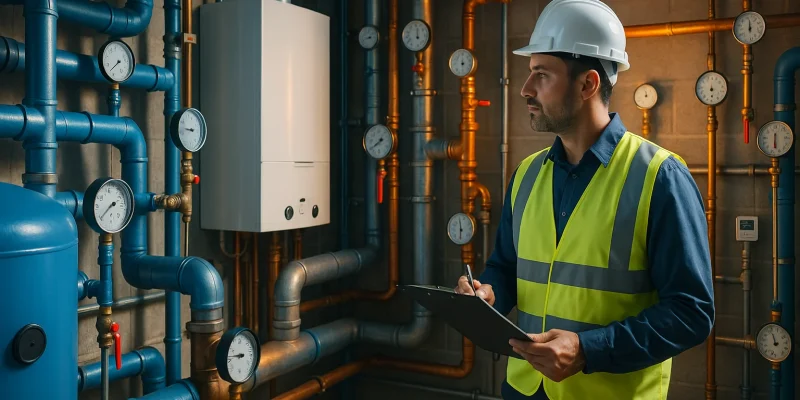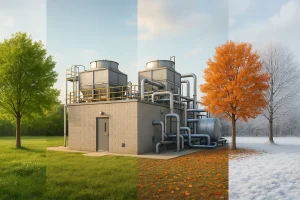
Legionella Seasonal Risk: How to Prevent Legionella Year-Round in Your Business?
What Is Legionella and Why Is It a Risk for Businesses?
Legionella bacteria are naturally found in freshwater environments like rivers and lakes, but when they enter artificial water systems such as cooling towers, hot and cold-water systems, or spa pools they can multiply quickly in the right conditions.
When contaminated droplets become airborne and are inhaled, they can cause serious respiratory illnesses, including Legionnaires’ disease.
Businesses with complex water systems such as offices, manufacturing plants, hotels, healthcare facilities, and leisure centres must remain vigilant.
Poor maintenance, temperature control, or stagnation can lead to bacterial growth and potential outbreaks.
Understanding How Legionella Risk Changes Through the Seasons

Although Legionella can grow at any time of year, environmental and operational factors cause the level of risk to fluctuate.
Knowing how these change by season helps ensure your water safety strategy stays effective.
Spring: Recommissioning and Rising Temperatures
- As outdoor temperatures increase, stored water may reach the ideal growth range (20°C–50°C).
- Systems dormant over winter season are reactivated, potentially spreading bacteria if not flushed or disinfected.
- Cooling towers and external systems begin full operation, requiring inspection and cleaning.
Summer: Peak Legionella Growth Season
- Warm ambient temperatures accelerate bacterial growth.
- Cooling systems, spa pools, and decorative fountains are in constant use.
- Cold-water systems may heat up above safe limits if exposed to external warmth.
- Higher humidity increases the risk of airborne droplets.
Autumn: Transition and Reduced Use
- Decreasing temperatures and occupancy can create low-flow or stagnant conditions.
- Building heating systems come online, potentially altering circulation and water temperature.
- Rainwater and organic debris can enter outdoor systems, creating new contamination points.
Winter: Hidden Risks in Low-Use Systems
- Water stagnation becomes a key risk where outlets are used infrequently.
- Lower demand can cause thermal stratification in tanks creating “warm zones” where Legionella thrives.
- Maintenance or monitoring may be scaled back, increasing the likelihood of unnoticed growth.
Legionella Prevention: 7 steps to Control Risk Year-Round
1. Create a Legionella Water Management Plan (WMP)
A written Water Management Plan is essential for compliance and prevention. It should include:
- A full Legionella risk assessment of your systems
- Schematic diagrams of your water infrastructure
- Clear control measures and temperature targets
- Defined responsibilities for monitoring and maintenance
- Documented records of testing, inspection, and corrective action
Regularly review and update your WMP to reflect changes in system use, building occupancy, or equipment.
2. Maintain Safe Water Temperatures
Temperature control is the most effective way to prevent Legionella growth:
- Hot water: Store at or above 60°C (140°F) and deliver to outlets at a minimum of 50°C (122°F).
- Cold water: Keep below 20°C (68°F).
- Test temperatures routinely at sentinel points across the system.
During summer, be alerted to rising cold-water temperatures; in winter, ensure tanks and heaters maintain consistent heat even with reduced flow.
3. Prevent Water Stagnation and Dead Legs
Stagnant or slow-moving water creates ideal growth conditions for bacteria.
- Identify and remove redundant pipework or dead legs.
- Flush infrequently used outlets (such as showers or guest room taps) at least weekly.
- After shutdowns or low-occupancy periods, flush and disinfect before reopening.
- Keep circulation pumps operational to maintain flow.
4. Clean and Disinfect Systems Regularly
Biofilm, scale, and sediment provide nutrients for Legionella. Regular cleaning and descaling are vital.
- Clean shower heads, taps, and outlets frequently.
- Inspect and disinfect storage tanks, calorifiers, and cooling towers in line with manufacturer and regulatory guidance.
- Maintain filters and dosing systems.
- Implement a documented schedule for cleaning and maintenance tasks.
5. Monitor, Test, and Record Results
Routine testing ensures your control measures remain effective.
- Check temperatures, flow rates, and disinfectant levels.
- Conduct periodic Legionella sampling, especially after maintenance or known control failures.
- Log all results and corrective actions ensuring accurate records are kept as they are a legal requirement and a key part of audit trails.
- Investigate and rectify any temperature deviations immediately.
6. Seasonal Legionella Maintenance Checklist
Use this year-round checklist to keep your water systems safe and compliant.
Spring
- Recommission systems and flush outlets after low use.
- Inspect cooling towers and water features before peak operation.
- Verify that disinfection systems are functioning properly.
Summer
- Increase monitoring frequency for both temperature and disinfectant levels.
- Inspect for biofilm or debris in tanks and pipework.
- Maintain continuous treatment in cooling towers and spa pools.
Autumn
- Review summer monitoring results and address any failures.
- Identify underused systems and schedule weekly flushing.
- Confirm insulation and heating systems are maintaining safe temperatures.
Winter
- Continue regular temperature and water quality checks.
- Flush outlets in low-use areas weekly.
- Inspect tanks for stratification and ensure heating is evenly distributed.
- Review and update your Legionella risk assessment.
7. Train Staff and Raise Awareness
Everyone responsible for water systems should understand how Legionella develops, how to recognise warning signs, and how to implement the control measures in your WMP.
Effective training ensures consistent maintenance and quick identification of potential risks before they become serious.
What are your Legal Responsibilities for Legionella Control?

Duty holders and responsible persons must take all reasonable steps to prevent or control the risk of Legionella. This includes:
- Conducting a Legionella risk assessment
- Implementing a written control scheme
- Maintaining water temperatures and preventing stagnation
- Cleaning and disinfecting water systems regularly
- Keeping up-to-date records of monitoring, testing, and remedial work
Legionella risk assessments should be reviewed by experts whenever the system, building, or usage changes significantly.
To conclude, Legionella prevention is not a seasonal task, it’s a continuous process that protects health, safety, and compliance.
By maintaining safe water temperatures, preventing stagnation, cleaning regularly, and reviewing risks with the seasons, you can keep your water systems safe all year.
A proactive, well-documented approach not only safeguards people but also protects your organisation’s reputation and operational continuity.
Protect your people and meet HSE requirements with professional Legionella risk assessments available across the UK. Simple, practical compliance support.




